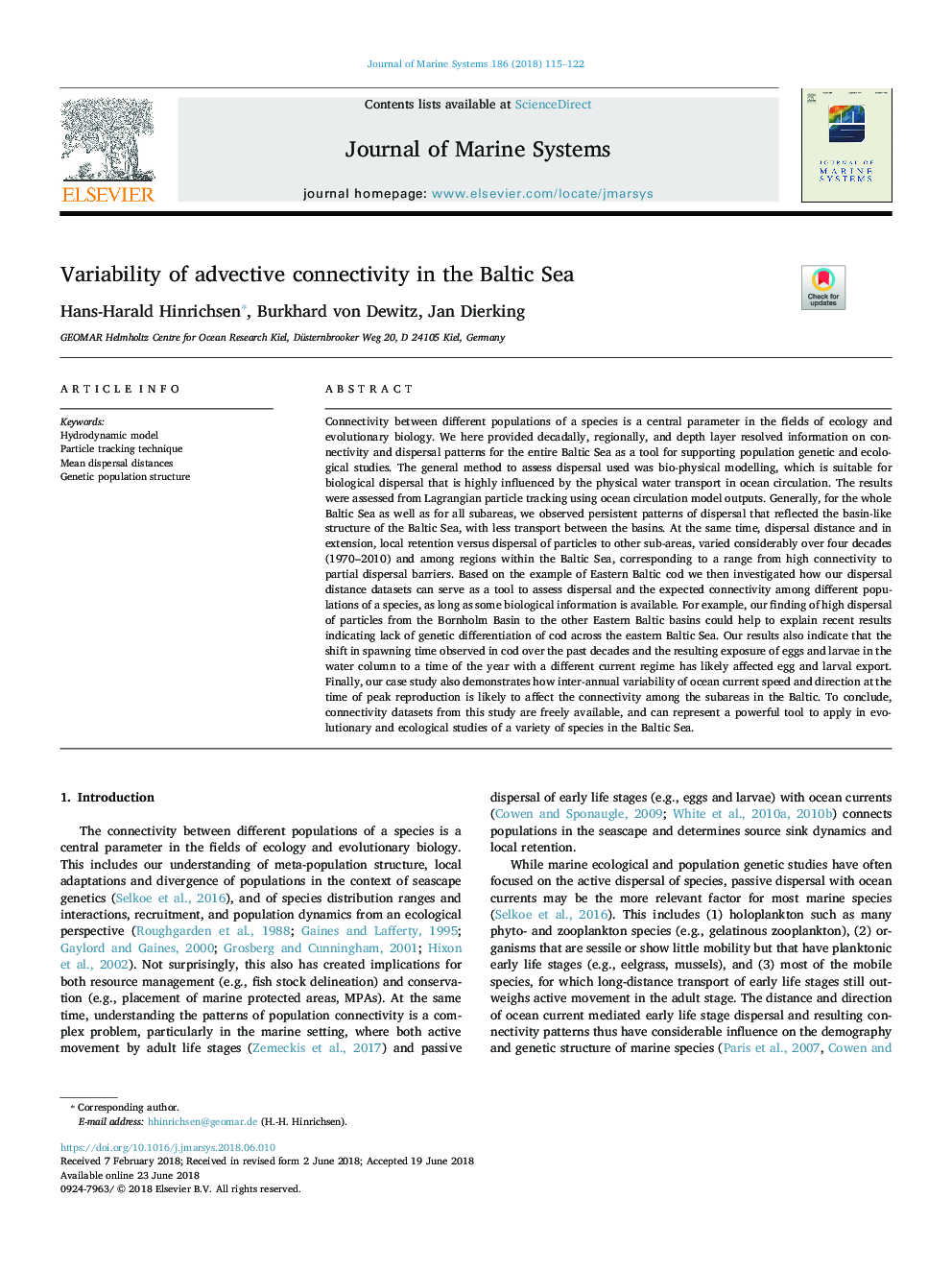| کد مقاله | کد نشریه | سال انتشار | مقاله انگلیسی | نسخه تمام متن |
|---|---|---|---|---|
| 8885920 | 1627244 | 2018 | 8 صفحه PDF | دانلود رایگان |
عنوان انگلیسی مقاله ISI
Variability of advective connectivity in the Baltic Sea
ترجمه فارسی عنوان
تغییرپذیری ارتباط متقابل در دریای
دانلود مقاله + سفارش ترجمه
دانلود مقاله ISI انگلیسی
رایگان برای ایرانیان
کلمات کلیدی
مدل هیدرودینامیکی، تکنیک ردیابی ذرات، فاصله های پراکندگی متوسط، ساختار جمعیت ژنتیکی،
ترجمه چکیده
اتصال بین جمعیت های مختلف گونه یک پارامتر مرکزی در زمینه های زیست شناسی و زیست شناسی تکاملی است. ما در اینجا ارائه دهه ها، منطقه ای و لایه عمق اطلاعات مربوط به اتصالات و الگوهای پراکندگی برای کل دریای بالتیک را به عنوان ابزار برای حمایت از مطالعات ژنتیک و محیط زیست جمعیت حل کردیم. روش کلی برای ارزیابی پراکندگی استفاده شده مدلسازی زیستی فیزیکی بود که برای پراکندگی بیولوژیکی مناسب است که به طور گسترده تحت تأثیر حمل و نقل فیزیکی آب در گردش آبزی قرار دارد. نتایج حاصل از ردیابی ذرات لاگرانژی با استفاده از خروجی مدل های گردش اقیانوس بررسی شد. به طور کلی، برای کل دریای بالتیک و همچنین برای همه زیرمیزی ها، ما شاهد الگوهای مداوم پراکندگی بودیم که ساختار دریایی بالتیک دریای بالتیک را بازتاب می داد و حمل و نقل بین حوضه ها کمتر بود. در عین حال، فاصله پراکندگی و گسترش، ضریب حفظ و نگهداری محلی نسبت به پراکندگی ذرات به مناطق دیگر، به طور قابل توجهی در طول چهار دهه (1970-2010) و در میان مناطق در دریای بالتیک متفاوت بود، که متناسب با دامنه ای از اتصال بالا به جزئی موانع پراکندگی بر اساس نمونه کد های شرقی شرقی، ما سپس بررسی کردیم که چگونه مجموعه داده های پراکندگی ما می تواند به عنوان یک ابزار برای ارزیابی پراکندگی و اتصال مورد انتظار در میان جمعیت های مختلف یک گونه، تا زمانی که برخی از اطلاعات بیولوژیکی در دسترس است. به عنوان مثال، یافته های ما در مورد پراکندگی زیاد ذرات از حوضه بورنولم به دیگر حوضه های دریای بالتیک بالتیک می تواند به توضیح نتایج اخیری که نشان دهنده عدم تمایز ژنتیکی کرم در دریای شرق بالتیک است کمک کند. نتایج ما همچنین نشان می دهد که تغییر در زمان تخم ریزی در ماهی های خوراکی در دهه های گذشته و در معرض قرار گرفتن تخم مرغ ها و لارو ها در ستون آب تا زمان سال با رژیم های متفاوت فعلی احتمالا بر صادرات تخم مرغ و لارو تاثیر می گذارد. در نهایت، مطالعه موردی ما نیز نشان می دهد که چگونه تغییرات بین سالیانه سرعت و جهت فعلی اقیانوس در زمان تولید حداکثر اوج، احتمالا بر ارتباطات در زیر حوزه های بالتیک تاثیر می گذارد. برای نتیجه گیری، مجموعه داده های اتصال از این مطالعه به طور آزاد در دسترس هستند و می توانند ابزار قدرتمندی برای اعمال مطالعات تکاملی و اکولوژیکی گونه های مختلف در دریای بالتیک باشند.
موضوعات مرتبط
مهندسی و علوم پایه
علوم زمین و سیارات
اقیانوس شناسی
چکیده انگلیسی
Connectivity between different populations of a species is a central parameter in the fields of ecology and evolutionary biology. We here provided decadally, regionally, and depth layer resolved information on connectivity and dispersal patterns for the entire Baltic Sea as a tool for supporting population genetic and ecological studies. The general method to assess dispersal used was bio-physical modelling, which is suitable for biological dispersal that is highly influenced by the physical water transport in ocean circulation. The results were assessed from Lagrangian particle tracking using ocean circulation model outputs. Generally, for the whole Baltic Sea as well as for all subareas, we observed persistent patterns of dispersal that reflected the basin-like structure of the Baltic Sea, with less transport between the basins. At the same time, dispersal distance and in extension, local retention versus dispersal of particles to other sub-areas, varied considerably over four decades (1970-2010) and among regions within the Baltic Sea, corresponding to a range from high connectivity to partial dispersal barriers. Based on the example of Eastern Baltic cod we then investigated how our dispersal distance datasets can serve as a tool to assess dispersal and the expected connectivity among different populations of a species, as long as some biological information is available. For example, our finding of high dispersal of particles from the Bornholm Basin to the other Eastern Baltic basins could help to explain recent results indicating lack of genetic differentiation of cod across the eastern Baltic Sea. Our results also indicate that the shift in spawning time observed in cod over the past decades and the resulting exposure of eggs and larvae in the water column to a time of the year with a different current regime has likely affected egg and larval export. Finally, our case study also demonstrates how inter-annual variability of ocean current speed and direction at the time of peak reproduction is likely to affect the connectivity among the subareas in the Baltic. To conclude, connectivity datasets from this study are freely available, and can represent a powerful tool to apply in evolutionary and ecological studies of a variety of species in the Baltic Sea.
ناشر
Database: Elsevier - ScienceDirect (ساینس دایرکت)
Journal: Journal of Marine Systems - Volume 186, October 2018, Pages 115-122
Journal: Journal of Marine Systems - Volume 186, October 2018, Pages 115-122
نویسندگان
Hans-Harald Hinrichsen, Burkhard von Dewitz, Jan Dierking,
